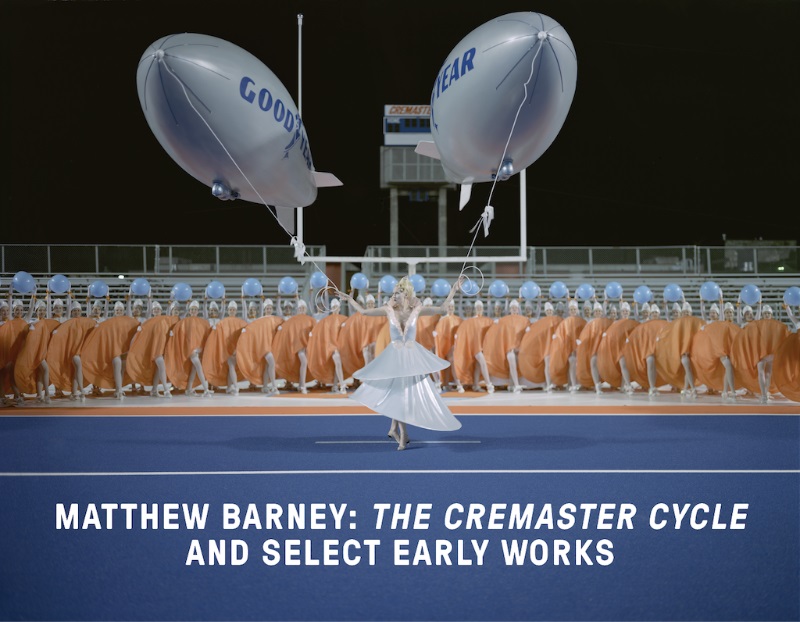Matthew Barney was born in Idaho in 1967 and became a star quarterback in high school. He was a Yale grad who took the New York art world by storm with his video installations, sculptures, and elaborate performance pieces. But for the loftiness of his achievements in what many would consider an airless and privileged environment, his work reveals his obsessions as reflections of his quotidian, all-American, some would say basic, origins. He likes ooze, the primordial kind that sticks and slides as a lubricant to his images of goat men in tailored white suits, navigating vaginal tunnels like misbegotten spelunkers forced into claustrophobic trials.
Three of his earliest works, bundled together as the “OTTO Trilogy,” trace what the Gladstone Gallery called “the training, discipline, and physical limits of the body alongside questions of sexual difference and desire.” Centered around former football player Jim Otto, not only is his name a palindrome, but his uniform number “00” suggests the infinity symbol and the concept of doubling while also working as a visual depiction of cellular meiosis—that is, the cell division of gametes, sex cells, in sexually-reproducing organisms. It seems like heady stuff, and it’s true that avant-garde cinema is not for every taste, but there’s an intoxicating compulsion and approachability to Barney’s work. His is the stuff of violent mass spectacle, human achievements on grand architectural and operatic scales, secret societies, and arcane rituals, and how the miracle of it all that creation is just an imperfect, Frankensteinian mirror to the mysterious and overlooked functions of biology.

Barney’s work emerges from tension, the titles of his pieces providing the ends of threads that, once pulled, open him up for contemplation, contextualization, and sometimes dissection. He is known for an ongoing video and photography series called Drawing Restraint, which describes a line between muscle growth and artistic production; River of Fundament is a three-act opera based on Norman Mailer’s Ancient Evenings; “Redoubt” employs the voyeurism and punishment myth of Diana and Actaeon in the exploration of what he called “humanity’s place in the natural world”; and now “Secondary,” which dramatizes a fateful American football game in which Patriots wide receiver Darryl Stingley is paralyzed in 1978 by a violent hit from Oakland Raiders defensive back Jack Tatum. Moving between the worlds of fine art and provocation, Barney is probably best known for his epic, eight-year, and five-film project “The Cremaster Cycle” (398 min), undertaken between 1994 and 2002.
Metrograph is hosting a rare screening of all five parts in the order in which they were created, which is not the order in which they are numbered, culminating with an in-person conversation with Barney and frequent collaborator Maggie Nelson. It is the first New York screening of this work since 2015. Barney has vowed there never be a broad home video incarnation.

“The Cremaster Cycle” is named for the muscle in male anatomy primarily responsible for raising and lowering testes in response to temperature. Its most disturbing, and arguably most sophisticated sequence is in the middle of its final and longest installment, “Cremaster 3,” in which its wordless hero, The Entered Apprentice (played by Barney himself), is strapped into a dentist’s chair at the center of the Chrysler Building, partially stripped and forced to ingest the crushed metal sepulcher, a violently-compressed 1938 Chevrolet Imperial, of serial murderer Gary Gilmore. Gilmore is played by Barney in “Cremaster 2” as a being born from a seance, gestated in a fleshy umbilicus stretched between two cars parked at a remote gas station, where the killer murdered attendant Max Jensen (Michael Thompson).
The Apprentice’s body’s response to the consumption of Gilmore’s body is profound, Cronenbergian, and repulsive. He expels his teeth, leaks viscous substances, and grows an apron of flesh. Meanwhile, the Freemason architect Hiram Abiff, played by sculptor Richard Serra, erects a black rubber construction somewhere else in the closed-off, secretive building to initiate its own metamorphosis into a thousand-foot maypole. It might seem to be a mere provocation for the sake of it, taking on dental fear with Masonic paranoia, but there are no non-sequiturs in Matthew Barney’s work. We are helpless but to be a product of our culture, he says. We are forced to consume it, and the consumption of it changes us.
Barney says there is a connection between Mormonism and the Masons; between Gary Gilmore and Hiram Abiff; and between all of them and each of us. Barney reaches back into Greek and Gaelic mythologies and forwards into speculative spaces where we force our bodies to evolve into biomechanical hybrids of surpassing strangeness and arcane, to us, function, and he ties it all together with the endless malleability of our flesh. Our cells divide and differentiate, and the labor of it is reflected in the patterns and ambitions of the products of our hands.

His “Drawing Restraint” series is literally about how the same ripping/repairing process we endure to build muscular strength, we use to develop artistic capacity. There is a natural pattern and precedent to everything: every behavior and every response, material or philosophical. It’s the kind of revelation one might glean from learning, for instance, of a muscle so specific as a cremaster. There is a design that governs the universe, and its only purpose is its own proliferation. If we can explain the evolutionary advantage of a cremaster muscle, can we not apply the same scientific method to why we make things?
Consider how “The Cremaster Cycle”’s various sequences of sexual titillation are tempered by an intimate consideration of all of the liquid effluvium left over from the sex act. A graphic penetration in “Cremaster 2” climaxes with honey ejaculate; the operatic “Cremaster 5” centers Ursula Andress as a diva who appears at the end of a beautiful aria to birth a glutch of frog’s eggs into a pale green pond fed by her tears.
The questions Barney wants to answer are ultimate questions. Is “sexiness” a product of a biological blueprint, and if so, what isn’t a product of a biological blueprint? Barney is fascinated by the human form but only in extremis, like artist Marti Domination in “Cremaster 1” cramped in the bowels of a Goodyear blimp in a shimmering silver dress, contorted into unnatural poses while her vehicle slowly documents a nighttime football game. Or, more to the point, like himself again in “Cremaster 3,” scaling the tiers of the Guggenheim Museum as representatives of various modes of storytelling and expression oppose his progress. It is only through the tension that the purpose of things emerges.
“The Cremaster Cycle” has been variously described as “narcotized self-satisfaction” (by J. Hoberman in The Village Voice, March 11, 2003) to “the first truly great piece of cinema to be made in a fine art context since Dali and Bunuel filmed ‘Un Chien Andalou’ in 1929” (Jonathan Jones, The Guardian, October 16, 2002). I lean more towards the latter while not seeing the former’s valid criticisms as necessarily a demerit. There is certainly a mesmeric quality to this six-and-a-half hour, essentially wordless enterprise, a certain hypnotic element born of some alchemy of repetition and revulsion that I think feeds into the piece’s power. Familiarity breeds contempt, it’s true, but it also allows for pattern recognition. If the most common knock against it is that it’s not “edited” into a coherent narrative that avoids repetition, that misses the point entirely. Repetition is the point. And if repetition is the point, so is self-indulgence and solipsism.
Matthew Barney’s collected work is Freudian autobiography. He is a surgeon operating on himself, and these investigations into the sources of creativity and ambition are his discoveries. I was reminded more than once upon this latest rewatch of his “Cremaster Cycle” of David Cronenberg’s latest film “Crimes of the Future,” in which an artist places his body in progressively onerous states of distress to force it to grow new tumors that his partner removes before an audience of adoring devotees. It’s exceedingly rare to get the opportunity to see Matthew Barney’s films in a theater. Go and be changed.












